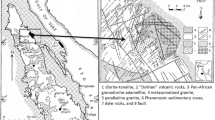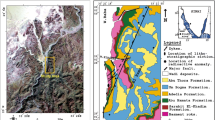Abstract
Mount Arafat is a sacred place for Muslims. It has been classified as a granodiorite rock which mainly consists of feldspar and quartz, muscovite, etc. During the Hajj and Umra, Muslims visit this holly place and stay there for some time. In order to study the geology and thermal history as well as to assess the radiological hazards due to the presence of primordial radionuclides, systematic studies using petrographic, fission track dating and γ-spectrometric (HPGe) techniques were carried out. Our study yielded fission track age of 9.13 ± 1.05 Ma of the Mount Arafat granodiorite. Rifting, magmatism, volcanism and sea floor spreading that resulted in the formation of Red Sea seems may have altered the original age of the Arafat granodiorite under study to 9.13 ± 1.05 Ma. Measured radioactivity concentrations due to 226Ra, 232Th and 40K were found to be 10.75 ± 3.92, 29.21 ± 4.34 and 664.49 ± 7.45 Bq kg−1, respectively. From the measured radioactivity, gamma index (Iγ) and radium equivalent (Raeq) were calculated as 0.402 and 103.23 Bq kg−1 whereas outdoor external dose (Dout) and annual effective dose (Eout) were estimated to be 40.30 nGyh−1 and 0.045 mSvy−1 respectively. All the above mentioned values are well below the recommended limits. The Mount Arafat thus does not pose any radiological health hazard to the general public.







Similar content being viewed by others
References
UNSCEAR (2000) Effects from natural radiation sources. United Nations Scientific Committee on Effects of Atomic Radiation, New York
Le Maitre RW (1989) Blackwell, Oxford, p 193
Abbady A (2005) Indian J Pure Appl Phys 43:589–593
Johnson PR (2006) Technical report SGS-TR-2006-4
Abdelsalam MG, Stern RJ (1996) J Afr Earth Sci 23:289–310
Camp VE (1984) Geol Soc Am Bull 95:913–921
Stoeser DB, Camp VE (1985) Geol Soc Am Bull 96:817–826
Qari MHT, Madani AA, Matsah MIM, Hamimi Z (2008) Arabian J Sci Eng 33(1C):99–116
Spadavecchia A, Hahn B (1967) Helv Phys Acta 40:1063–1079
Durrani SA, Bull RK (1987) Solid state nuclear track detection: principles, methods and applications. Pergammon Press, Oxford
Yang YX, Wu XM (2005) Appl Radiat Isot 63:255–259
Benke R, Kearfott J (1999) Nucl Instrum Methods 422:817–819
Akhtar N, Tufail M, Ashraf M, Iqbal MM (2005) Radiat Meas 39:11–14
Le SC, Ken CK, Lee DM, Kang HD (2001) Radiat Prot Dosim 94:269–274
ASTM (1986) Recommended practice for investigation and sampling soil and rocks for engineering purpose. Annual Book of ASTM Standards, Philadelphia, PA
Tufail M, Akhtar N, Javied S, Hamid T (2007) J Radiol Prot 27:481–492
Tufail M, Akhtar N, Waqas M (2006) Health Phys 90:361–370
Matiuullah A, Rehman SU, Faheem M (2004) Radiat Prot Dosim 112:443–447
Malik F, Matiullah, Akram M, Rajput U (2011) Radiat Prot Dosim 143:97–105
Pallister JS (1986) US Geological Survey I/USGS, Denver
Karadeniz O, Cıyrak N, Yaprak G, Akal C (2011) J Radioanal Nucl Chem 288:919–926
Rusko M, Andras P (2010) Faculty of material sciences & technology in Travara, Slovak University of Technology in Bratislava, no. 29
Beretka J, Marthew PJ (1985) Health Phys 48:87–95
Ibrahim N (1999) J Environ Radioact 43:255–258
Rehman S, Matiullah, Mujahid SA, Hussain S (2008) J Radiol Prot 28:205–212
ICRP (1999) Recommendations of the International Commission on radiological protection. Pergammon Press, Oxford
Sannappa J, Ningappa C, Narasimha KNP (2010) Indian J Pure Appl Phys 48:817–819
Gbadebo AM, Ayedun H, Okedeyi AS (2011) Environ Res J 5(2):25–30
Ahmed NK, Abbady A, El Arabi AM, Michel R, El Kamel AH, Abbady AG (2006) Radiat Meas 44:209–215
EC (1999). Radiological protection principles concerning the natural radioactivity of building materials. Radiation protection 112, Directorate General Environment, Nuclear Safety and Civil Protection, European Commission, Luxembourg
ICRP (1991) Recommendations of the International Commission on radiological protection. ICRP Publication 60, Ann. ICRP 21, nos. 1–3
Ibrahim N (1999) J Environ Radioact 43:255–258
Ali M, Qureshi AA, Waheed A, Baloch MA, Qayyum H, Tufail M, Khan HA (2011) Environ Monit Assess. doi:10.1007/s10661-011-2290-5
Author information
Authors and Affiliations
Corresponding author
Rights and permissions
About this article
Cite this article
Qureshi, A.A., Sultan, A., Rashid, A. et al. Geological and radiological studies of the Mount Arafat, Mekkah, Saudi Arabia. J Radioanal Nucl Chem 293, 955–963 (2012). https://doi.org/10.1007/s10967-012-1776-0
Received:
Published:
Issue Date:
DOI: https://doi.org/10.1007/s10967-012-1776-0




